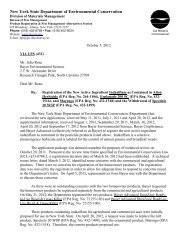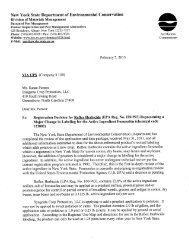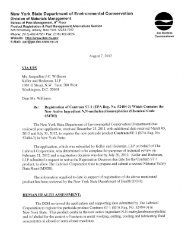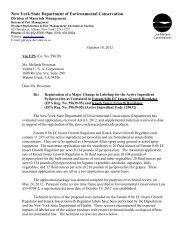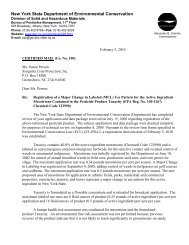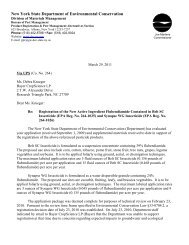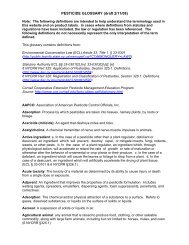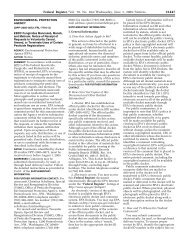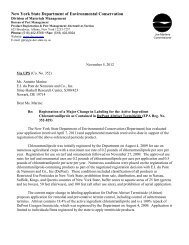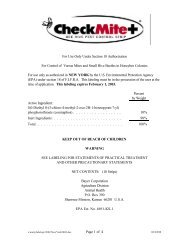Prothioconazole/Trifloxystrobin
Prothioconazole/Trifloxystrobin
Prothioconazole/Trifloxystrobin
Create successful ePaper yourself
Turn your PDF publications into a flip-book with our unique Google optimized e-Paper software.
Ms. Karen Cain 6.<br />
ENVIRONMENTAL FATE ASSESSMENT:<br />
The following assessment was prepared by Engineering Geology staff within the Bureau<br />
of Pest Management.<br />
Technical Review of <strong>Trifloxystrobin</strong><br />
No environmental fate information was submitted for this active ingredient, so this review was<br />
taken from the November 12, 1999 technical review of trifloxystrobin done for Flint and<br />
Compass.<br />
Solubility: <strong>Trifloxystrobin</strong> has a solubility of 0.61 ppm.<br />
.<br />
Hydrolysis: <strong>Trifloxystrobin</strong> was stable in pH 5, has a half-life of 55.2 days at pH 7, and<br />
19.8 hours at pH 9.<br />
Aqueous Photolysis: <strong>Trifloxystrobin</strong> had a half-life of 14.8 days; however EPA had<br />
problems with this study.<br />
Soil Photolysis: Degradation was too rapid to determine a half-life.<br />
Aerobic Soil Metabolism: The half-life was biphasic with an apparent half-life of 0.72 days.<br />
The registrant calculated half-life was 2.0-2.4 days. Degradate CGA 321113 was found at 85.2%<br />
at 7 days in one study, at 93.2% at day 14 in a second study, and at 84.7% at 28 days and 39.5%<br />
at one year in a third study. CGA-357276 was found at 4.9% at 270 days, CGA-373466 and<br />
CGA-357262 were each found at < 4.1% from days 90 to 365 in the second study. CGA-<br />
373466, CGA-357261, CGA-331409 and CGA-320299 were each found at 1% throughout the<br />
third study.<br />
Aerobic Aquatic Metabolism: EPA was not satisfied with this study, but did state that the<br />
study indicated that trifloxystrobin degraded rapidly in aquatic aerobic environments.<br />
Anaerobic Aquatic Metabolism: The half-life was 0.72 days<br />
Aged Leaching: EPA did not accept this study, but did indicate that degradate CGA-321113 was<br />
very mobile in loamy sand, sandy loam and silt loam as well as mobile in loam and clay loam.<br />
CGA-356276 was present in quantities too low to assess mobility.<br />
Adsorption-Desorption Parent:<br />
Soil Type Adsorption Koc Desorption Koc<br />
Loamy sand 2354 3294<br />
Sandy loam 951 1387<br />
Low OM sand 3064 3528<br />
High OM sand 3927 2202<br />
Clay loam 9871 2504<br />
Silt loam 951 1203



